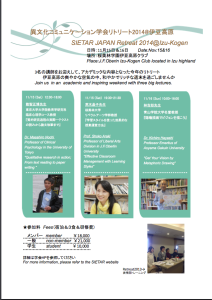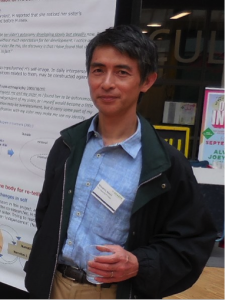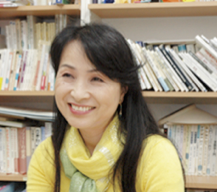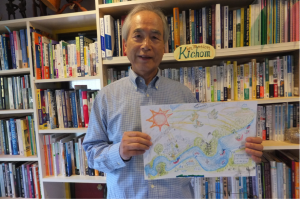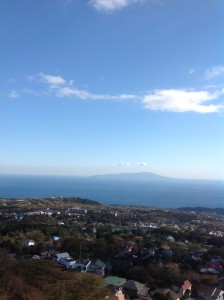

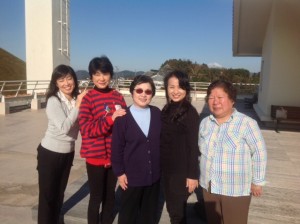
秋さわやかな伊豆高原で、楽しい学びと親睦の時間を共有する機会です。
[場所] 「桜美林学園 伊豆高原クラブ」
[日時] 11月15〜16日(土曜&日曜)
[ セミナー講師]
1)能智正博先生(東京大学大学院教授): 質的研究法
2)荒木晶子先生(桜美林大学教授): 教授法(teaching style)
3)林吉郎先生(青山学院大学名誉教授): メタファードローイング(metaphoric drawing)
[ 参加費]
1)学生:1泊3食+セミナー付き 10000円
*学生証の提示が必要です
*学生料金で宿泊した場合の食事は「学生用メニュー」です
2)会員:1泊3食+セミナー参加費 18000円
3)非会員:1泊3食+セミナー参加費 21000円
(昨年の様子は、活動報告ページよりご覧ください)
**また、セミナーとは別に、参加者からの発表も募集します。
発表を希望される方は発表内容と所要時間を、お知らせください。
お申し込み多数の場合は、当方で調整させていただきます。
申し込み方法
こちらからのファイルをご覧いただき、メールにてお申し込みください。
チラシは下記の画像(↓)をクリック
プログラム詳細
※ 現時点でお伝えできる情報のみ掲載いたします
【テーマ】
「質的研究過程の実際―テクストの読みから論文執筆まで―」
【概要】
質的研究は、現在我が国の人文・社会科学の様々な分野で広がりを見せている研究法です。それは単に言語を用いた研究の方法ではなく、対象の意味に注目しつつ、自然場面でデータ収集を行い、基本的に帰納的な分析をおこないつつ、対象を新たな視点からモデル化することを目指す研究上の構えです。近年は質的研究の方法に関するテクストも増加し、研究者の間での認知も広がってきましたが、具体的な手続となるとまだ雲をつかむようでわかりにくいという声を聞くことがあります。今回のセミナーは、そうした質的研究法について研究過程の実際を体験し、その技法や手続についての理解を深めることを目標としています。
内容は3つに分かれており、第一部では、質的研究がどういう本質をもつかを、語り研究に注目しながら簡単に解説します。その後、第二部では、具体的なサンプル・データを用いて、質的研究でもっとも使われることの多いカテゴリー分析を体験する機会を提供します。第三部では現在博士論文執筆中の大学院学生の協力を得て、近年論文として学術誌に掲載された質的研究事例を用い、論文化までの道のりと専門誌に掲載されるまでの工夫やコツを紹介します。今回のセミナーを通じて、受講される方々のそれぞれが、自分の関心をどう質的研究にのせ、データをどのように質的に分析して論文化できるのかなどの問いに答えるための、ヒントを提供できればと思っています。
【プロフィール】
能智正博:愛媛県生まれ。東京大学文学部卒。同大学院を経て、Syracuse大学大学院教育学研究科でPh.D.を取得。現在は、東京大学大学院教育学研究科臨床心理学コース教授。著書に、『臨床心理学を学ぶ6 質的研究法』(東京大学出版会, 2011), 『質的心理学ハンドブック』(新曜社,共編著, 2013)など。
[Theme]
Qualitative research in action: From text reading to paper writing
[Abstract]
Qualitative research is gaining popularity in many disciplines of humanities and social sciences. It is not just a research method that involves a language use but an attitude in which to collect data in natural settings, to make a basically inductive analysis, and make a model on the object from a novel viewpoint. These years, textbooks that deal with qualitative methodology have increased in number, and more researchers have recognized its benefits for empirical projects. However, I often hear people say that its specific procedures are still vague and inaccessible. This seminar will give an opportunity in which participants can go through a process of qualitative research, using concrete data, in order to deepen an understanding of its methods and techniques.
The seminar will consist of three sections. First, I will briefly present an essence of qualitative research, focusing on narrative inquiry. Second, I will give an opportunity to analyze sample data to help you understand a qualitative analysis for contents or meanings. Third, I will show you a process of getting published in corporation with a doctoral student who recently published his research. Through this seminar, I wish I can provide you some hints and advices so that each participant can embody his or her own research ideas, answering questions on qualitative research.
[Profile]
Masahiro Nochi was born in Ehime, Japan. He graduated from the Department of Letters in the University of Tokyo and got a Ph. D. at Graduate School of Syracuse University, USA. Presently, he is a professor of Clinical Psychology in the University of Tokyo. He is the author of “Shitsuteki Kenkyuho (Qualitative methods) “ (2011), and a co-author/editor of “Shitsuteki Shinrigaku Handobukku (Qualitative Psychology Handbook)” (2013).
【テーマ】
「体験学習の学習スタイルを考慮した効果的な授業運営方法」
【概要】
近年、大学入試形態の多様化にともない、入学してくる学生の質も、学ぶ学生たちの目的も一昔前と比べると、ゴールも大きく様変わりしています。この「多様化する学生の期待とニーズに応え、どんな学生にとっても満足度の高い、効果的な授業運営をするにはどうしたらいいのか、教員にとって頭の痛い問題です。
この10年、20年、学生の質が年々様変わりしているのであれば、教員である私たち自身も、学生の変化に対応した授業運営を求められています。いつまでも学生の質の低下を嘆いているだけでは、学生と教員の溝は深まるばかりです。
今回は、このような溝を少しでも埋め、効率のよい授業を展開するために、体験学習(Experiential Learning)をもとに、誰もがもっている学習スタイル(Learning Style)に注目し、学習スタイルをどのように取り入れることで、効果的な授業運営ができるのかを考えます。
今回紹介する4つの学習スタイルは、「直接体験型(Concrete Experience)、「抽象概念型(Abstract Conceptualization)、「内省概念型(Reflective Observation)」、「思考実験型(Active Experimentation)」です。
私たち人間は、その4つのスタイルすべてを取り入れながら学習をすることでさらに学習効果が高まります。新しい情報収集をするときに、それぞれの個人に得意なスタイルであると学習効果があがり、苦手なスタイルだけに偏っていると学習効果は思うように上がりません。
まず、教員自身が自分に得意な学習スタイルがなんであるのかを知る必要があります。なぜなら、私たちは無意識のうちに、自分がよいと思う自分の得意な学習スタイルで授業を行っていますが、そのスタイルが学生にとって同じ得意なスタイルとは限りません。
今回のセッションでは、この4つの学習スタイルを紹介し、それぞれに特徴的な学び方とともにそれぞれに固有な学習スタイルを理解してもらいます。また、自分の得意な学習スタイルを知るとともに、授業で取り入れる様々な授業運営方法(講義、グループ討論、エクササイズ、レポート)の強みと弱みを検討し、90分の授業の中に、この4つの学習スタイルをどのようにと取り入れて効果的に授業を運営できるのかを考えます。
90分の授業の中に、これらの学習スタイルをまんべんなく取り入れることで、異なる学習スタイルをもつ学生一人一人にあって情報提供ができ、学習効果も上がり、学生にとって満足度の高い授業を提供することができます。
また教員自身も、自分に得意な学習スタイルと苦手な学習スタイルを理解することで、自分にとって苦手な学習スタイルも積極的に取り入れ、どの学生にとっても公平な授業を行うことができるようになります。
現在の大学教員に求められるもの、それは専門分野の知識はもちろんですが、それを効果的に伝えるための授業運営能力が強く求められています。学習者にとって、毎回の授業が楽しみになるような授業展開ができ、どの学生にとっても、公平で、知的好奇心あふれる学習環境を創り上げることのできる教員自身の「創造力」と「実践力」が求められていると思います。今回のセッションでは、参加者の皆さんからも、さまざまな授業運営方法を紹介していただければと思います。
【プロフィール】
荒木晶子:桜美林大学リベラルアーツ学群教授
サンフランシスコ州立大学大学院(修士号取得:異文化コミュニケーション)、スタンフォード大学客員研究員、IRI(Intercultural Communication Institute)でCross-Cultural Trainer。
帰国後NHKの国際放送の仕事に従事するとともに、外資系および日本企業で異文化研修を担当。SIETAR Japan創立者の一人として活躍しSIETAR Internationalから異文化教育特別功労賞を受賞。1990年から桜美林大学に勤務、現在に至る。
著書:「自分を活かすコミュニケーション力」「伝わるスピーチAtoZ」「自己表現力の教室」「異文化コミュニケーション・ワークブック」など
[Theme]
Effective Class Management by use of Learning Style of Experiential Learning
[Abstract]
In the past several years, many college students have undergone vast changes owing for the most part to a diversified entrance examination system. As a result, teachers must learn to cope and adjust to such changes and effectively manage classes. In addition, the diversification and high expectations of students present a difficult challenge that must be satisfied. In this session, we will introduce and examine incorporating “learning style” based on “experiential learning”. The four types of learning styles are: Concrete Experience, Abstract Conceptualization, Reflective Observation, Active Experimentation.
It’s important to note that both teachers and students have their own learning style based on their upbringing and life experiences. What happens if the learning style of the teacher is not compatible with that of the student? It may become practical for the teacher to compromise and make adjustments to satisfy the student’s expectations.
I will introduce the four styles and how each is different from the other. I must emphasize that each style has both strengths and weaknesses and that one style is not better than the other. The old rule of thumb of assessing your students and adjusting your teaching style has worked for the most part in managing classes.
It is always in the best interest for teachers to create a favorable, non-threatening learning environment where students can feel comfortable and have their intellectual curiosity stimulated.
We welcome and appreciate your active participation in this session.
[Profile]
Shoko Araki is a Professor of Liberal Arts at J.F. Oberlin University. She earned an MA in Intercultural Communication at graduate school of San Francisco State University. She was a visiting researcher at Stanford University, and worked as a cross-cultural trainer at Intercultural Relational Institute while she was in USA. After she returned to Japan, she engaged in international broadcasting at NHK and worked as a facilitator at several foreign-affiliated companies and Japanese corporations for their cross-cultural communication training.
She is a co-founder of SIETAR Japan and received a special prize from SIETAR International for her distinguished service in intercultural training. She’s been teaching at J.F. Oberlin University since 1990. Her authored works include “jibun wo Ikasu communication ryoku”, “ tsutawaru speech A to Z”, “ jiko hyogen ryoku no kyoushitsu”, and “ ibunka communication work book”.
【テーマ】
「隠喩描画でビジョンを描こう」
【概要】
ビジョンは、自分が自分であることの証だといっても過言ではない位の事柄だと考えられていますが、鮮明で生きたビジョンを持っている人は案外少ないようです。また夢とビジョンの違いもあまり知られていません。ご存知のポートランドのSIICでファシリテーションをしていた頃、MD(メタフォリック・ドローイング~隠喩描画)も多用していましたが、未来志向の価値観を持つといわれているアメリカ人、カナダ人でも、具体的なビジョンを持っている参加者がことのほか少なく驚きました。反対に、日本で行った150回ばかりのMD研修でも、参加者の多くが、学部生、院生、外資系マネジャーなども含めて、ビジョンをMDで表現しダイアログすることによって新たなビジョンを開発することは、参加者にも思いの外楽しく、未来への想像性が刺激されるということが分かりました。
修辞法(rhetoric)としての隠喩が、想像性・創造性の啓発に不思議と役立つことは周知のことで、文学でも日常生活でも頻繁に使用されています。またメタファー、隠喩(暗喩)、直喩などを含む比喩の研究は、古代ギリシア・ローマ時代からの長い歴史を持っています。ただ隠喩描画は別で、これまであまり研究されてこなかったようです。このワークショップでは、隠喩とは、その比喩との違いは、隠喩はなぜ想像性を高めるか、といったメタファー論に焦点を合わすのではなく、隠喩描画に飛び込んで、ビジョンを隠喩描画として描き、その絵を鑑賞する他者との対話を通じて具体的で生きたビジョンの開発にどう役立てるかを実戦的に経験学習したいと思っています。
ワークショップでは、最初に隠喩描画の実例を十数点見て頂いてから、各自がご自分のビジョンをメタフォリックにスケッチします。年配の男性など、絵など描いたことがありませんと言う方がいますが、MDでは芸術的に描く必要はありません。ただ絵はアナログ知覚とデジタル知覚からなっていますので、それについてのガイドは短時間致します。同時にメタフォリックなドローイングでは、実際の現実世界のイメージをメタフォリックなイメージに転換する作業を伴いますので、2世界間の距離が生れます。この距離の扱いがアナ・デジ間の距離と掛け算して不思議にも想像性の啓発に繋がる可能性を秘めています。やってみて下さい、面白いです。
一回目はちょっと何がなんだか分からないところを歩く感じになる可能性がありますので、ワークショップでは野球でいう2~3回戦できればと思います。最後のご自分のワークはお持ち帰り頂き、ゼミで、また日曜日にご家族とMDをすれば、素敵な未来指向の家族やクラスが生まれるかも知れません。また、私はバイリンガルではなくバイコンセプチュアルですが、今回のベース言語は英語とし、その時の都合で参加者のサポートもお願いして日英間を行ったり来たりしたいと思っています。参加者のみなさんもその様にお願いします。パラダイムや理論を含めて、どんなご質問も大歓迎です。質問がなければ私から理論的な展開は最小限とする予定です。
【プロフィール】
林吉郎:堺市生まれ。神戸大学経営学部卒。インディアナ大学経営学部よりMBA、経済学部よりPh.D.取得。Indiana U, UCLA, American Grad Sch of International Management, McMaster U (Canada)外で在北米15年、教歴8年。青山学院大学名誉教授。大平正芳(総理大臣)記念賞、経営科学文献賞、SIETAR Intercultural (Washington, D.C.)より1995 Outstanding Senior Interculturalist Award for Achievementを受賞。専門は異文化マネジメント。最近の研究は、意識、想像性、知覚へのNew Science Approach。著書10冊、論文約70点、最新共著書は『本当の自分がわかる6眼心理テスト』(創元社)。
[Theme]
Get Your Vision by Metaphoric Drawing”
[Abstract]
Vision is often considered to be an expression of your real self. You meet few people, however, who have a clear live vision. As a result, the difference between dream and vision is not too often discussed in depth. When I used to facilitate at SIIC in Portland, I often used Metaphoric Drawing (MD in this writing) in connection with envisioning. My usual finding in these classes, however, was that not too many American and Canadian participants had concrete visions to my surprise, though they were much interested in visionary leadership. I have experimented MD workshops in Japan about 150 times with my students and corporate managers and found that the participant was well stimulated creatively and found both drawing and subsequent dialogue enjoyable beyond expectation.
It is a well-known fact that metaphor as rhetoric has power to enhance creative imagination, thus used often in literary work as well as in daily life. Research in the figure of speech such as metaphor, simile, allegory and personification has history since the times of ancient Greece and Rome. Metaphoric drawing for the purpose of creativity, however, has not really been well researched. Our workshop this time will not be focused on theory but on practical experiential learning in the use of MD for effective envisioning and imaginative dialogue based on the drawing. Please note that this aspect of MD is creative intercultural communication.
In this workshop, I wish to show you 15 to 20 examples of metaphoric drawing for you to ask questions mainly about how to draw. Then you go right into drawing your tentative or ingrained vision. Some well-experienced businessmen told me that they could not draw anything because they have never drawn anything for zillion years. The purpose, however, is not to produce an artistic piece. Since drawing, however, consists of analog and digital perception, I wish to provide brief guidance in this point. MD also involves some work to transform an image of real world into a metaphoric world, creating some distance between the two worlds. How to deal with this distance multiplied by analog digital distance hides the magical seed to enhance human imagination. You will find an intriguing excitement in this process.
There is a possibility in the first round of MD experience that you would feel as if you were walking in heavy mist. To walk out of this mist, I would like you to experience a few rounds in the workshop. If you would bring home your last MD for imaginative dialogue with your family or students, I would not be surprised if you started creating a wonderfully future-oriented family or class.
I am not bilingual but bi-conceptual, so that I wish to use English as the base language for those who are not yet too comfortable with Japanese only. However, I wish to use Japanese as well depending upon the need of the moment. In some occasion, I may need to ask some bilingual person to translate for me or for someone. Any questions will be welcome including matters of theory or paradigm in the workshop. Otherwise, I wish to minimize a theoretical lecture.
[Profile]
Kichiro Hayashi, Ph.D., Professor Emeritus of Aoyama Gakuin U.
“Gifts” received includeFulbright grant, MBA + Ph.D. from Indiana Univ., late Prime Minister Masayoshi Ohira’s Memorial Prize, 1995 Outstanding Senior Interculturalist Award from SIETAR International (Washington, D.C.), and Management Science Literature Prize.
“Joy” experienced includes teaching at Indiana Univ., UCLA, American Graduate School of International Management, McMaster U. in Canada for a total of 8 years as well as Aoyama Gakuin U. for 27 years. Trained 3000 international leaders from 80 countries sponsored by the government. Trained several hundred expatriates of about 20 multinationals. Also served as UNDP Consultant for the Center of Transnational Corporations for 4 years.
“Pain felt” includes writing 10 books and 70 professional articles.
“Recent activities” include research in visionary imagination, analog/digital perception & communication, and paradigmatic creativity and innovation.
多くの皆様のご参加をお待ちしております。

